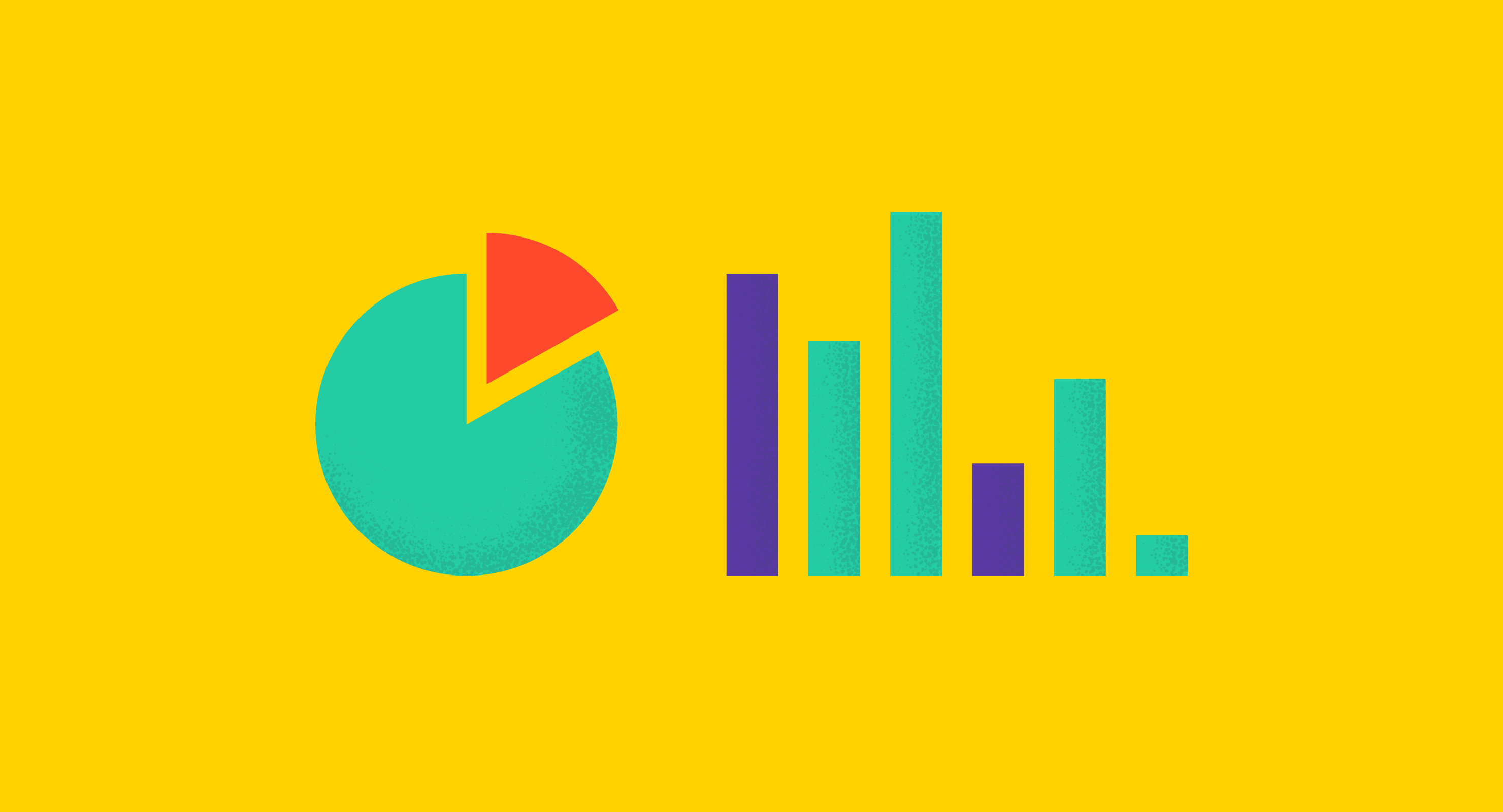In a world where new businesses are popping up every day, brand visibility is everything.
Digital marketing is the answer to getting your brand in front of thousands of new potential customers using social media, mobile marketing, and all that good stuff.
But where do you start? Which platform should you focus on? Do you engage digital marketing services, and which strategies are worth your time? There are plenty of questions to answer.
That’s why we’ve put together the top digital marketing statistics for 2025. These insights into content and email marketing, search engine optimization (SEO), video marketing, and artificial intelligence (AI) will help refine your strategies and keep you ahead of the curve.
Top 5 digital marketing statistics for 2025
- The digital marketing industry is expected to grow at a CAGR of 13.1% from 2024 to 2032, reaching $1,099.33 billion.
- Search advertising is the digital market’s biggest segment, with a volume of $202.40 billion.
- Businesses typically earn $5 for every dollar spent on digital marketing.
- The average internet user now spends 6 hours and 40 minutes online daily.
- Millennials are the most active social media demographic, with 68.8% estimated users in 2024.
General digital marketing statistics
Whether your company is business-to-business (B2B) or business-to-consumer (B2C), digital marketing is the most effective tactic to gain more visibility, customers, and revenue for your company. Here are some general statistics to give you an idea of the digital marketing landscape.
- 49% of marketers say that organic search has the best return on investment (ROI).
- Digital advertisements can increase a brand’s awareness by 80%.
- Over 90% of people read reviews online before making a purchasing decision.
10,000
the number of ads the average person sees per day.
Source: Siteefy
- 66% of consumers believe the majority of digital ads don’t cater to their interests or needs.
- 78% of marketers say they have a small marketing team of between one and three people. These teams usually included a writer (52%), a social media manager (36%), and an SEO specialist (34%).
- Only 29% of consumers find it easy to understand how a company protects their personal data.
Content marketing statistics
Content marketing is a strategy in which marketing teams post relevant and engaging content to boost the value and visibility of their products or services. A great example of this is when marketing teams create informative blogs that establish their brand as a thought leader in their respective field. Here are some statistics about how real marketers are using content marketing in their larger digital marketing strategy.
- Small and medium-sized businesses (SMBs) report spending an average of $10,000 on content marketing per year.
- Nearly 80% of very successful content marketers spend more than 10% of their total marketing budgets on content.
- 87% of marketers who’ve used webinars found them effective.
- 67% of marketers report SEO as the most effective tactic they implement to grow their content strategy.
- 62.3% of content marketers include interactive elements in their content marketing strategy.
- 60% of video marketers list their top key performance indicators (KPIs) as engagement rate, followed by conversion rate (56%) and click-through rate (52%).
- 52% of marketers say social media and community building is a top priority, as is improving content quality, followed by audience research.
- Content marketing is actively used by 29% of marketers.
- 84% of marketers list “brand awareness” among their B2B content marketing goals.
- Companies with blogs produce 67% more leads per month than those without.
- 61% of enterprise marketers say creating the right content for their audience is a key challenge.
- The leading content formats are videos (94%), short articles or posts (93%), and case studies/customer stories (79%).
- Just 39% of enterprise marketers believe their organization effectively measures content performance.
- 23.5% of internet users worldwide listen to podcasts.
- 83% of traffic to marketing blogs comes from desktops.
- For content distribution, 91% rely on social media, 75% on email newsletters, and 71% on blogs.
Website statistics
Websites are an excellent approach to increasing your digital market authority. We've reviewed some intriguing website-building statistics and how they influence online user experiences.
- 88.5% of people leave the website due to the slow loading of the website.
- Slow-loading websites costs retailers $2.6 billion in sales annually.
- Videos on a website can increase the average time spent on a page by 88%.
- Website visitors spend an average of 6.44 seconds focused on the main navigation menu.
46%
of U.S. websites received between 1,001 and 15,000 monthly visitors in 2023.
Source: HubSpot
- WordPress is the most popular content management system (CMS), housing 43.5% of the internet’s websites.
- 72% of small businesses have a website, while 28% do not.
- The average click-through rate across all industries is 6.64%.
Email marketing statistics
Email marketing remains the best digital marketing channel for ROI. Although it can be expensive and a bit tedious at times, time and time again, email marketing works. But what are the best ways to ensure your message stands out in a crowded inbox? These email marketing statistics can give you a good idea of where to get started.
- The average person checks their email at least 20 times a day.
- Both consumers and marketers rank email as their preferred method of communicating.
87%
of brands consider email marketing crucial to their business success.
Source: Litmus
- Emails with multimedia elements have the highest performance.
- Mobile-friendly email is the second most popular strategy implemented by email marketers to increase their ROI.
- 20% of marketing email campaigns are not optimized for mobile phones.
- You can expect to earn a staggering $36 back for every dollar you spend on email marketing.
- The best time to send a marketing email is between 9 am-12 pm EST and the worst time is between 1 am -3 am EST.
- Tuesdays have the highest click-through rates – 2.4%, while Saturdays and Sundays observe the lowest CTR – 2.1%.
- Roughly 45.6% of all emails sent in 2023 were classified as spam.
- 60% of consumers subscribe to a brand’s list to get promotional messages and deals, compared to only 20% who follow brands on social media.
- Segmented email campaigns have a 30% higher open rate and a 50% higher click rate compared to non-segmented email campaigns.
- QA, A/B test, and spam testing emails generate higher ROI.
- 65% of marketers sent emails with personalized subject lines in 2023.
Lead generation statistics
Lead generation is one of the most essential metrics marketers are judged against. However, getting people to fill out lead forms and sign up for email newsletters is hard. These statistics outline which lead generation strategies will give you the best results and how you can optimize your lead funnel to generate higher quality leads faster than ever.
- Leads that are actively nurtured by marketing produce 20% more sales opportunities.
- Companies that nurture leads generate 50% more sales at 33% lower costs.
- Landing pages have the highest conversion rate (23%), while pop-ups have the second-lowest conversion rate (3%).
- The average cost of a B2B sales lead is around $200.
- 80% of B2B companies use content marketing for lead generation.
53%
of marketers spend at least half of their budget on lead generation.
Source: WebFX
- Only 17% of marketers A/B test their landing pages to improve conversion rates.
- Customers are only willing to wait five seconds for your page to load before it starts to bounce.
- 42% of companies consider email to be one of their most crucial lead generation channels.
- 73% of leads are not sales-ready the first time they interact with your brand.
- 63% of leads who inquire about your business won’t be ready to convert for at least three months.
- 61% of marketers say lead generation is their number one challenge.
- Leads are nine times more likely to convert when businesses follow up within five minutes.
- The majority of midsize and large companies generate less than 5,000 qualified leads each month, with the average being 1,877 leads per month.
- 66% of marketers report using social media to generate leads.
- Most marketers agree that LinkedIn is the most effective social media channel for B2B lead generation, but only 47% of marketers use LinkedIn.
Pay-per-click (PPC) statistics
PPC is a digital advertising approach in which the advertiser pays a charge each time one of their advertisements is clicked on. PPC advertisements come in various kinds and sizes (literally) and can contain text, graphics, videos, or a combination of the three. They may be found on search engines, web pages, social networking platforms, and other sources. Let us take a look at some interesting figures associated with PPC advertising.
- PPC generates 2x the visitors as compared to SEO.
- Mid-sized businesses invest between $9,000 to $10,000 on PPC every month.
$190.5 billion
is the projected spend on search advertising globally in 2024.
Source: Statista
- The Google Display Network is the leading PPC provider with over 2 million sites in its program.
- 65% of all high-intent searches result in an ad click.
- Paid ads and social media account for less than 10% of B2B website traffic, leads, or sales.
Mobile marketing statistics
Mobile marketing is a digital marketing strategy in which marketing teams attempt to reach their audience on their phones through channels such as text messaging and email. A business with an effective mobile marketing strategy will optimize its web pages for mobile viewing as well as all of its email marketing. Here’s a look at how marketers can make mobile marketing work for them.
- One in four internet users are already mobile-only consumers, meaning they only access the internet using a cell phone.
- 51% of smartphone users have discovered a new company or product when conducting a search on their smartphones.
- 76% of people search on their smartphones for something nearby or want to visit a business the same day.
- 33% of SMS recipients react to call-to-actions (CTAs) in SMS marketing messages, and 47% of those end up making a purchase.
$3.4 trillion
is the forecasted value of mobile e-commerce sales by 2027.
Source: Statista
- SMS marketing click-through rates for e-commerce brands can be as high as 36%.
- Mobile application conversion rates are 3x higher than a mobile website.
- 59% of shoppers surveyed say that being able to shop on mobile is important when deciding which brand or retailer to buy from.
- 61% of people tend to shop on mobile websites that allow them to apply search filters.
SEO statistics
SEO is a popular method for generating traffic to a brand website by ranking for popular search queries. Companies that want to drive traffic through SEO often conduct research on significant keywords that internet users are commonly searching for. They then focus on content optimization by creating targeted pieces around these keywords to drive more traffic to their site.
These statistics show the best SEO strategies in your digital marketing efforts.
- There are an estimated 8.5 billion searches on Google each day, which is equivalent to 99,000 search queries every second.
- 85% of marketers report using website analytics and SEO tools to track their campaigns.
- The top 500 most popular search terms make up 8.4% of all search volume.
- 90.63% of pages get no organic search traffic from Google.
YouTube
is the most searched keyword both in the U.S. and globally.
Source: Ahrefs
- The #1 result in Google’s organic search results has an average CTR of 31.7%.
- 64% of marketers actively invest time in SEO.
- Organic traffic is responsible for 53% of traffic to all websites.
- The top-ranking result in Google has an average of three times more backlinks than positions two through ten.
- Google Analytics is the number one SEO tool used by marketers.
Social media statistics
Social media is one of the most popular digital marketing channels, and it’s only expected to grow. Marketers have trusted platforms like Facebook, Instagram, and Twitter for a long, long time. But what about new opportunities like TikTok and Snapchat? Are they worth your time and marketing budget? Have a look below.
- Businesses allocate around 15% of their marketing budget toward social media marketing.
- 62% of people said they were more interested in a product after seeing it in a Facebook Story.
- 82% of social media leads come from Twitter. However, only 22% of U.S. adults report using Twitter.
- More than 300 million people worldwide use Pinterest every month.
- YouTube is the second most popular website after Google.
- Only 11% of marketers consider making use of user-generated content to be a tactic worth using.
- 81% of marketers have synced their social media platforms with commerce systems.
- LinkedIn is the second-most popular social media platform used by B2B marketers, ranking only behind Facebook.
- The most common publishing cadence for social media marketers is three to four times per week.
2.35 billion
people interact with Instagram’s story feature every month.
Source: SourcePilot
- Almost a quarter of online U.S. adults say they have come across videos posted on TikTok.
- More than 1 billion videos are viewed on TikTok every day, and an ad on it can reach up to 885 million.
- India is home to the most Instagram users – 326.6 million.
- 68% of marketers report using influencers in a campaign.
- Facebook has an advertisement reach of 2.14 billion.
- Snapchat has 383 million daily active users, as per the latest figures.
- Influencer marketing has an ROI of 650%, as marketers get $6.5 for every $1 invested.
Video marketing statistics
Video marketing has seen a massive boom in popularity in the last few years. Because videos are often expensive and time-consuming to produce, most marketers are still unaware of the benefits these resources can bring their brand. Here are some of the best video marketing statistics for marketers to keep in mind.
- 80% of video marketers claim that video has directly increased sales.
- 72% of customers prefer learning about a product or service by way of video.
- Video has become the most commonly used format in content marketing, overtaking blogs and infographics.
- A website is 53 times more likely to reach the front page of Google if it includes video.
- YouTube is the world’s biggest video-sharing platform and 2nd most prominent social media. People watch 1 billion hours of videos on YouTube each day.
55%
of marketers plan to focus on creating AI-assisted explainer or brand videos this year.
Source: Lemonlight
- 84% of people say that they’ve been convinced to buy a product or service by watching a brand’s video.
- 79% of video marketers use Facebook as a video marketing channel.
- 87% of video marketers on LinkedIn described the platform as an effective video marketing channel.
- Mobile video consumption rises by 100% every year.
- People are twice as likely to share video content with their friends than any other type of content.
- 87% of video marketers say that video has increased traffic to their websites.
- Promotional videos and brand storytelling are the most common video types marketers create.
- Videos under two minutes long get the most engagement.
- People are able to retain a message 95% better when the information is received in the form of a video compared to just 10% when reading it in text.
AI in digital marketing
AI has been around for a long time, but adoption rates skyrocketed with the advent of ChatGPT. Marketers employ AI for various functions, including image production, podcast script authoring, and even video editing. Marketers are also adjusting to this transition by investing in AI marketing solutions. Take a look at these fascinating statistics regarding the use of AI in marketing.
- 50% of marketers believe inadequate adoption of AI is holding them back from achieving their goals.
- 19.2% of marketers spend over 40% of their marketing budget on AI-driven campaigns.
- 91% of Fortune 1000 companies are increasing their investment in artificial intelligence.
9 out of 10
marketers turn to generative AI tools for creating content.
Source: G2
- The adoption of generative AI is highest in the marketing and advertising sector (37%). Technology (35%) and consulting (30%) are the other two sectors showing increased use of AI.
- 60% of marketers implement AI to predict customer behavior and needs.
- 26% of businesses are applying AI techniques such as natural language processing (NLP) to marketing and sales.
Digital marketing: the future-proof strategy for growth
With all of the different ways that businesses can market their product, it is clear that we are living in the golden age of digital marketing. By leveraging the power of data-driven insights, creative content, and strategic online platforms, businesses can unlock the full potential of digital marketing to drive growth, build brand recognition, and connect with customers in previously unimaginable ways.
Whether you’re an SMB looking to get your brand off the ground or an enterprise brand hoping to reach even more customers, digital marketing can provide a wealth of information and tools to choose from.
Troubled by SEO? Check out how to do an SEO Audit with a free checklist.
 by Lauren Pope / December 23, 2024
by Lauren Pope / December 23, 2024
 by Lauren Pope
by Lauren Pope
 by Bianca Pasare
by Bianca Pasare
 by Washija Kazim
by Washija Kazim
 by Lauren Pope
by Lauren Pope
 by Bianca Pasare
by Bianca Pasare


